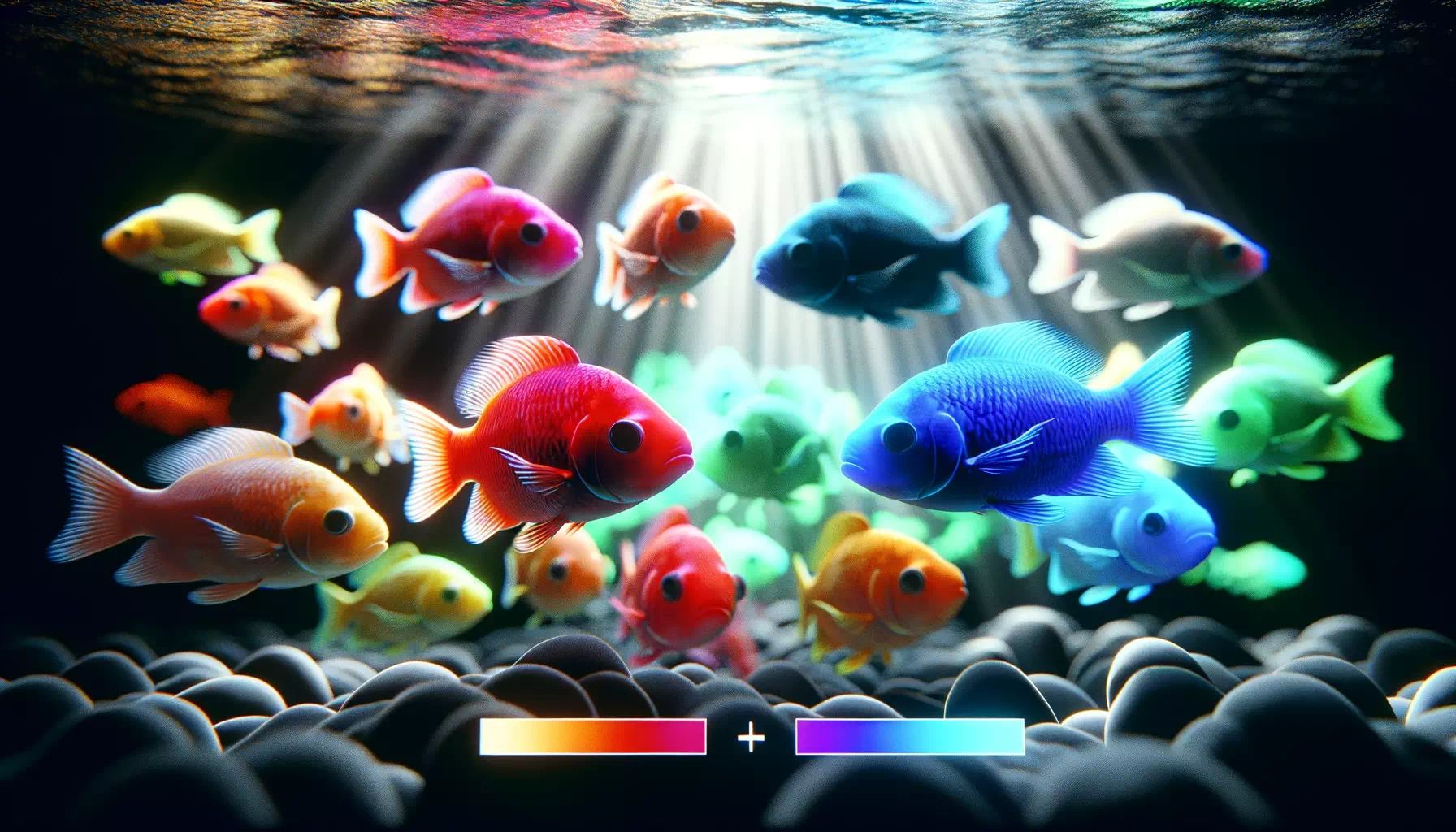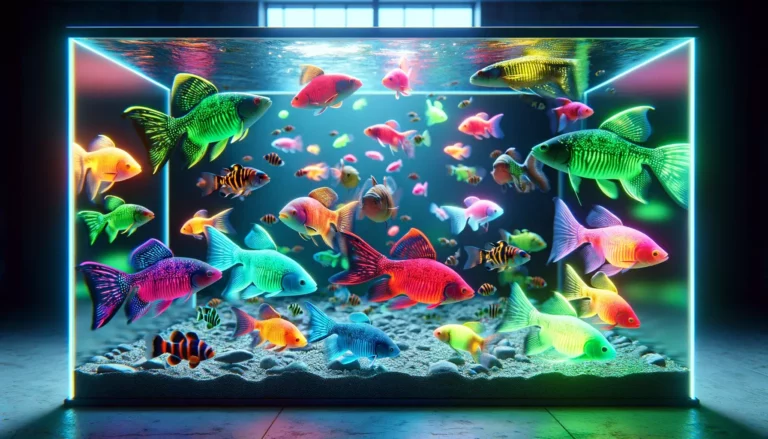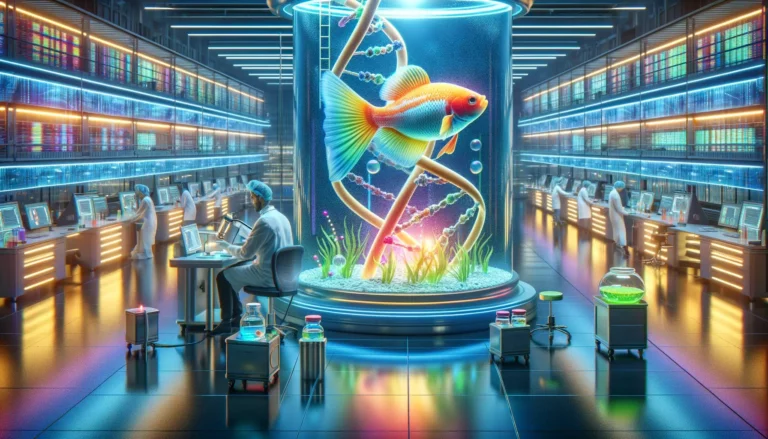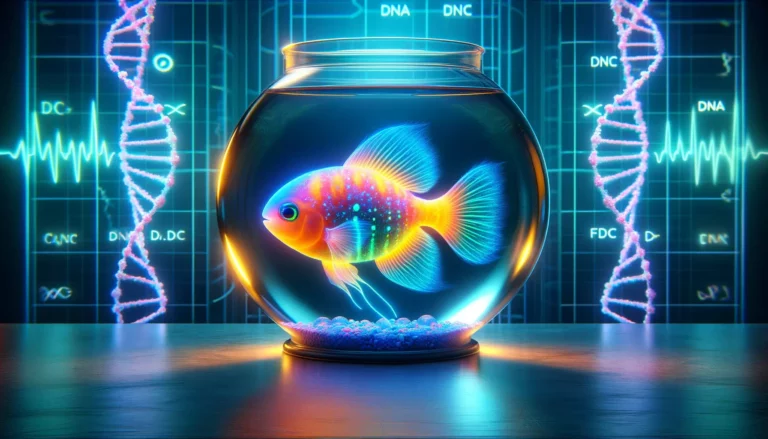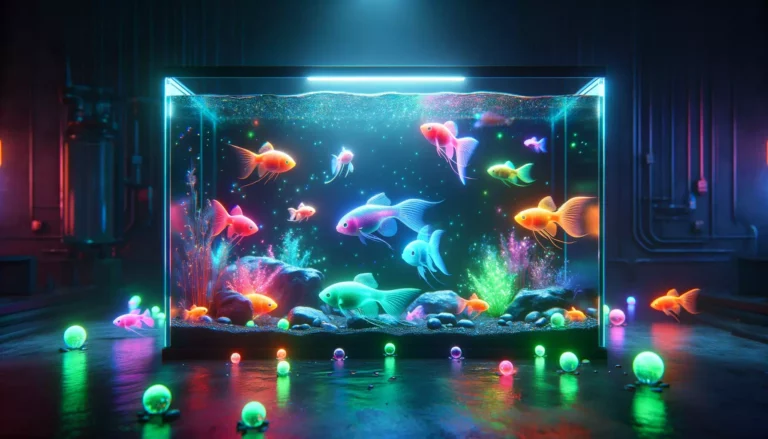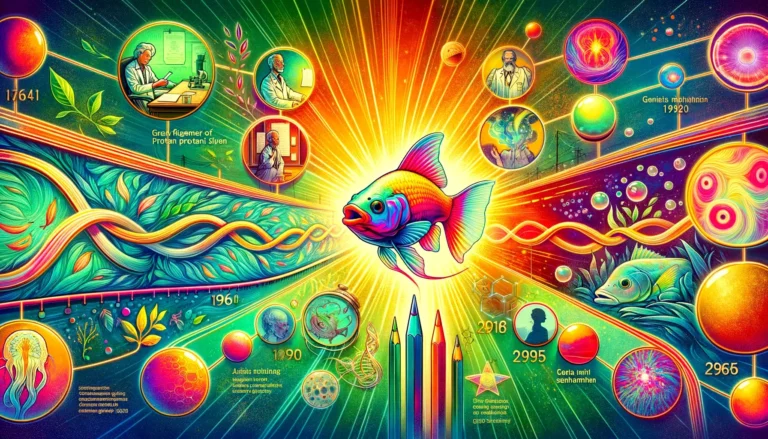Genetic Origins of GloFish Colors
GloFish are a result of genetic engineering. Their origins trace back to scientific research. In the 1990s, scientists began experimenting with fluorescent proteins. These proteins were originally found in jellyfish and coral.
The main goal was not to create ornamental fish. Initially, researchers aimed to develop environmental sensors. These fish were to detect pollutants in water. The fluorescent trait proved useful for this purpose.
Researchers inserted genes responsible for fluorescence into fish embryos. This resulted in fish exhibiting bright, fluorescent colors. Various genes led to different colors. These genes originated from various marine organisms.
GloFish were first marketed in the early 2000s. They quickly gained popularity in the pet trade. Their unique colors attracted aquarium enthusiasts. These fish were among the first genetically modified pets.
Species Diversity and Color Variations in GloFish
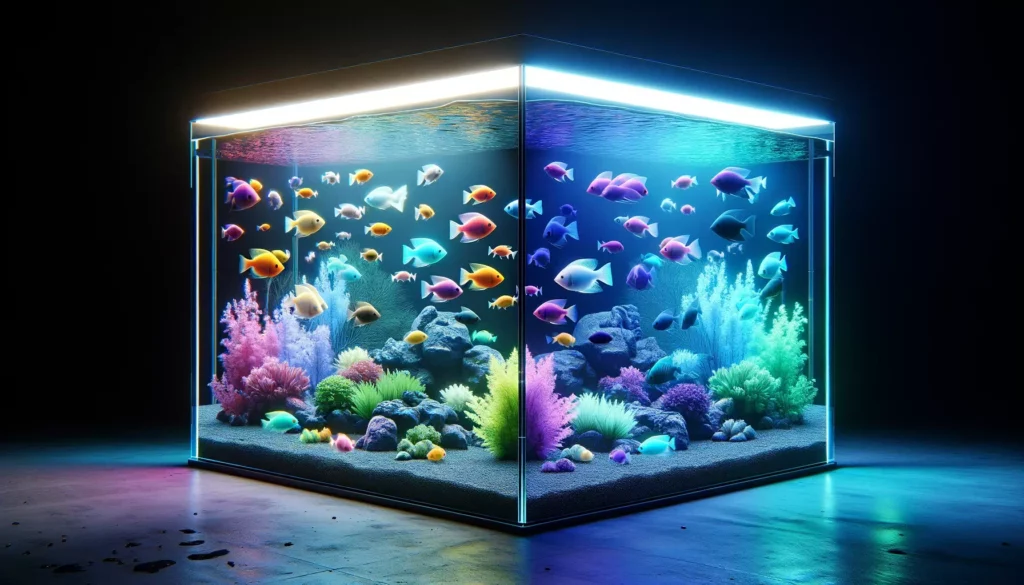
GloFish are available in several species. Each species exhibits unique color variations. The most common species are zebrafish, tetras, and barbs. Each species has been genetically modified for color.
Zebrafish were the first GloFish species available. They display a range of fluorescent colors. Tetras and barbs followed, with their own color variations. These species also show vibrant hues. This diversity caters to different preferences in the pet trade.
The colors in each species are distinct. Zebrafish might show brighter hues than tetras. The color variations are due to specific genetic modifications. Each species thus has a unique appeal.
Color variety in GloFish enhances their popularity. It allows enthusiasts to create diverse aquarium setups. This diversity reflects the success of genetic engineering in pets. It also demonstrates the potential for future developments.
Genetic Modifications Leading to GloFish Color Changes
Genetic modifications in GloFish are precise. They involve inserting specific genes into fish embryos. These genes are responsible for producing fluorescent proteins. The process is done under controlled laboratory conditions.
The genes come from various marine organisms. For example, the green fluorescent protein (GFP) originates from jellyfish. Other colors like red and orange come from coral species. Each color in GloFish corresponds to a specific gene.
This process is highly regulated and ethical. It ensures the safety and health of the fish. The modifications do not affect the fish’s lifespan or behavior. They simply alter the coloration.
The result is a range of vibrant, fluorescent colors. These colors are visible under normal and ultraviolet light. They have made GloFish a popular choice among aquarium enthusiasts. The technology showcases the possibilities of genetic engineering.
Impact of Environmental Factors on GloFish Coloration
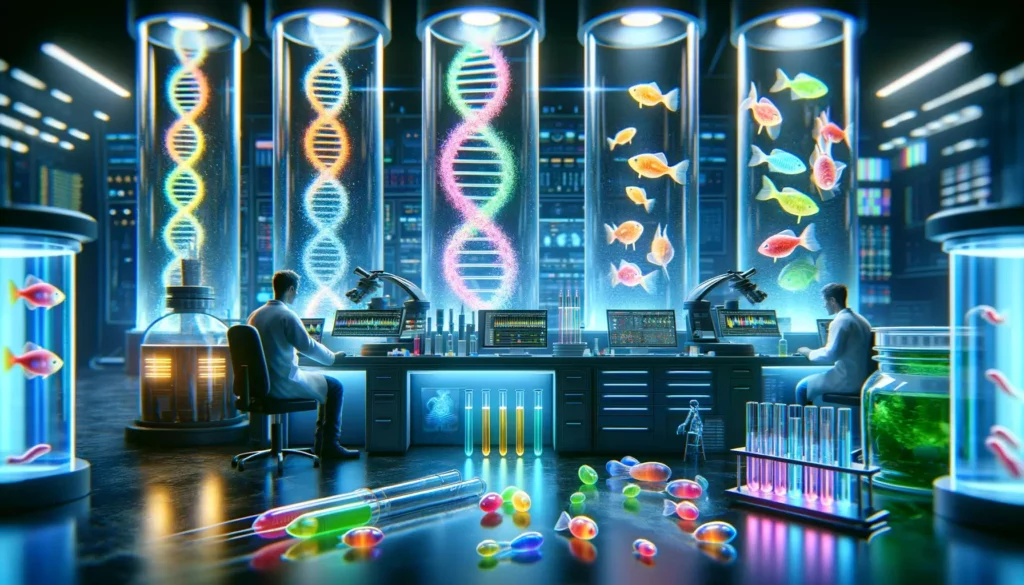
Environmental factors significantly influence GloFish coloration. Lighting conditions are particularly crucial. Proper lighting enhances the fish’s fluorescent colors. Under ultraviolet light, GloFish colors become more vivid.
Water quality also affects color vibrancy. Clean, well-maintained aquariums support brighter colors. Poor water conditions can lead to duller coloration. Regular water changes and filtration are essential.
Temperature and diet play roles as well. Optimal temperatures promote better health and color. A nutritious diet can enhance color brightness. GloFish fed with enriched foods often display more vibrant colors.
Stress factors can impact color negatively. Crowded tanks or aggressive tank mates can cause stress. Stress can lead to faded colors in GloFish. Providing a peaceful environment is key to maintaining color vibrancy.
Color Intensity Variations Across Different GloFish Species
Different GloFish species exhibit varying color intensities. Zebrafish often display brighter colors than other species. This is due to their genetic makeup and the types of fluorescent proteins used.
Tetras and barbs, on the other hand, might have softer hues. Their genetic modifications differ from zebrafish. This results in different color intensity levels. These variations cater to different preferences among enthusiasts.
The breeding environment also influences color intensity. Breeders can enhance colors through selective breeding. This can lead to more intensely colored offspring. It’s a continuous process to develop brighter and more vibrant GloFish.
The color intensity in GloFish can also vary within a species. Individual genetic differences contribute to this. Some fish might naturally exhibit stronger colors than others. This diversity adds to the appeal of GloFish in aquariums.
Age-Related Changes in GloFish Coloration
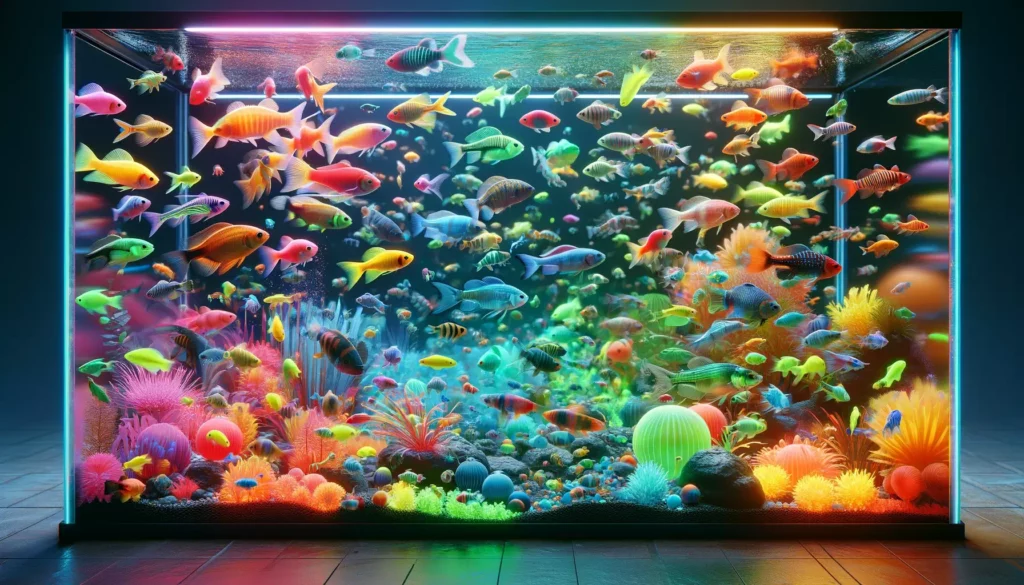
GloFish colors can change as they age. Young GloFish usually display more vibrant colors. As they grow older, some may experience color fading. However, this is not always the case and varies by individual.
The change in color with age can be subtle. It often depends on the species and care conditions. Proper care can maintain color vibrancy longer. A healthy diet and optimal aquarium conditions are key factors.
In some cases, colors may become more pronounced with age. Mature GloFish might develop deeper hues. This is particularly true for well-cared-for fish. Regular care and stable environments support this color development.
Age-related color changes are a natural process. They reflect the life cycle of the fish. Understanding and accepting these changes is part of GloFish keeping. It adds an interesting dynamic to the hobby.
Influence of Diet on GloFish Color Vibrancy
The diet of GloFish plays a significant role in their color vibrancy. Nutrient-rich foods enhance their fluorescent colors. Specialized fish foods, enriched with color-boosting ingredients, are available. These foods contain carotenoids and other nutrients that intensify coloration.
A varied diet is key to maintaining bright colors. This includes a mix of flakes, pellets, and live or frozen foods. Such diversity ensures a balanced intake of essential nutrients. It directly impacts the color brightness and overall health of the fish.
Overfeeding, however, can dull GloFish colors. Excess food leads to poor water quality and stress. Both of these factors can negatively affect coloration. Proper feeding routines are therefore essential.
In summary, a nutritious, well-balanced diet is crucial for vibrant GloFish colors. It not only affects their appearance but also their health and well-being. Aquarium enthusiasts should focus on providing a diet that caters to the specific needs of their GloFish.
Color-Related Health Implications in GloFish
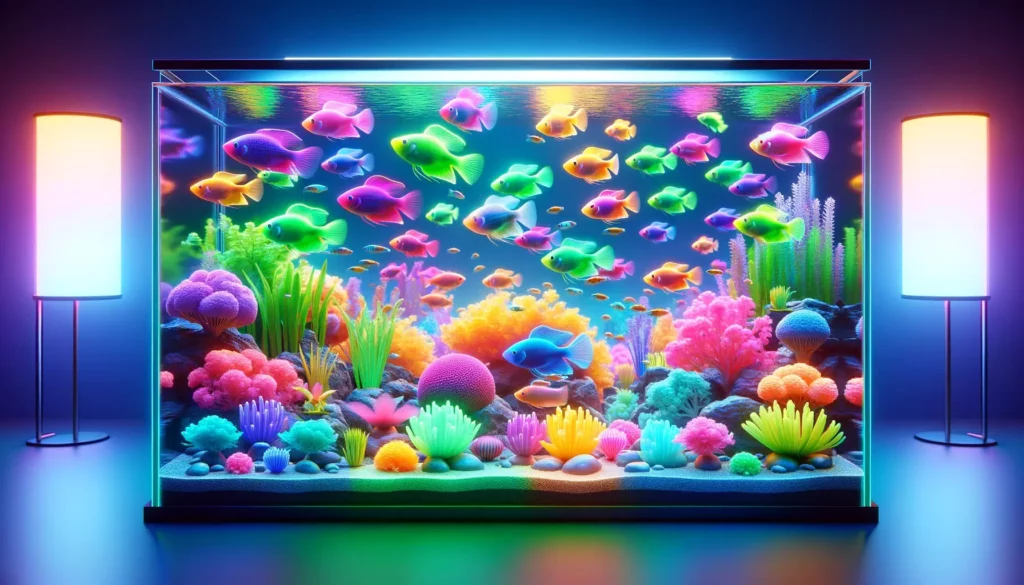
Color changes in GloFish can sometimes indicate health issues. Sudden or drastic color fading might signal a problem. Stress, poor water quality, or illness can cause color loss. Observing any changes in color can help in early detection of health issues.
However, it’s important to note that GloFish colors are genetically engineered. The fluorescent colors themselves do not pose health risks. The genetic modifications are stable and do not affect the fish’s overall health.
Regular health checks are important. This includes monitoring their activity levels, appetite, and appearance. Any noticeable changes might require attention. Consultation with a veterinarian specializing in fish can provide guidance.
Healthy GloFish typically display bright, vivid colors. Maintaining a suitable environment is key to their well-being. This includes proper filtration, temperature control, and regular tank cleaning. A healthy environment ensures not just vibrant colors but also a healthy life for GloFish.
Effects of Aquarium Lighting on GloFish Colors
Aquarium lighting dramatically affects GloFish colors. Specific types of light can enhance their fluorescent glow. LED lights, especially those with a blue spectrum, are effective. They make GloFish colors appear brighter and more vibrant.
Regular white aquarium lights also illuminate GloFish well. However, the fluorescent colors are most pronounced under blue or black lights. Such lighting creates a striking visual effect. It highlights the unique beauty of GloFish.
It’s important to balance light exposure. Too much light can stress the fish. It can also lead to algae growth in the tank. A consistent light schedule helps maintain a healthy environment.
Experimenting with different types of lighting can be rewarding. It allows aquarium enthusiasts to display GloFish colors in various ways. The right lighting setup can turn an aquarium into a stunning showcase of fluorescent beauty.
Recent Developments in GloFish Coloration
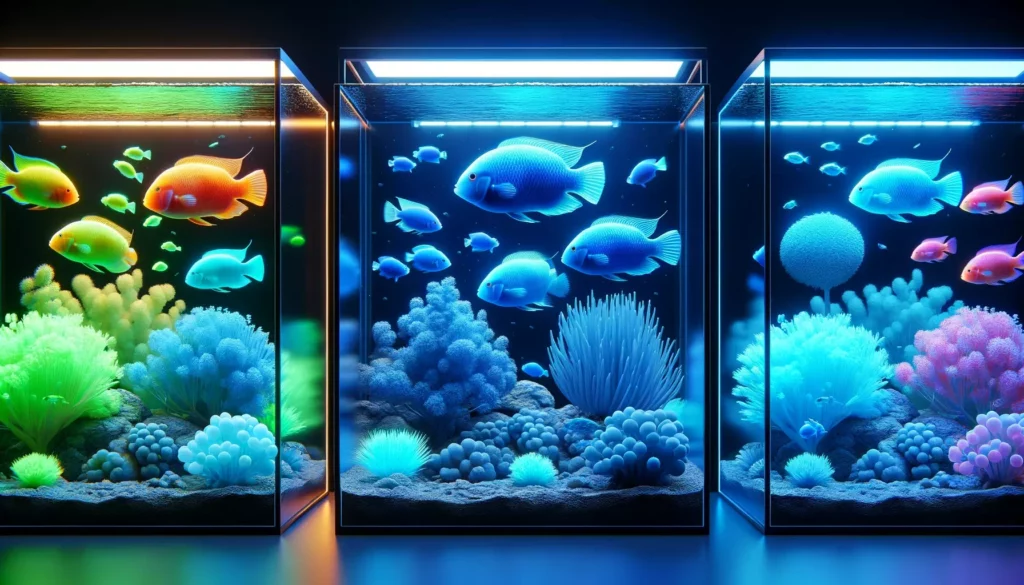
The field of GloFish coloration is continually evolving. New colors and patterns are being developed. Advances in genetic engineering techniques have enabled this progress. These developments provide even more variety for aquarium enthusiasts.
Recent trends include creating GloFish with multiple colors. Bi-color or even tri-color GloFish are becoming more common. These advancements add complexity and beauty to GloFish varieties. It’s a significant step from the single-color GloFish initially available.
Researchers are also focusing on improving color brightness and longevity. The aim is to create GloFish that maintain their vibrant colors throughout their lifespan. Efforts are also being made to develop GloFish that are more resilient to environmental changes.
These innovations reflect the growing interest in ornamental fish. They demonstrate the potential of genetic engineering in pet fish breeding. The future of GloFish coloration seems bright, with possibilities for even more stunning and diverse color patterns.
Popular GloFish Colors Among Aquarium Enthusiasts
Among aquarium enthusiasts, certain GloFish colors stand out in popularity. Electric green and radiant pink are highly sought after. These colors are vivid and easily noticeable in aquarium settings. They provide a striking visual contrast when combined with other fish and decorations.
Blue and purple GloFish are also popular. Their deeper hues offer a more subdued, yet equally mesmerizing, visual experience. These colors tend to be popular for creating a calming aquarium ambiance.
The appeal of certain colors can vary based on personal preferences and tank setups. Some enthusiasts prefer a mix of colors for a diverse and vibrant display. Others might choose a specific color theme for a more harmonized look.
Overall, the popularity of certain GloFish colors reflects the desire for visually appealing and unique aquarium experiences. These preferences continue to drive the market and inspire new developments in GloFish coloration.
Regulatory and Ethical Considerations in GloFish Color Breeding
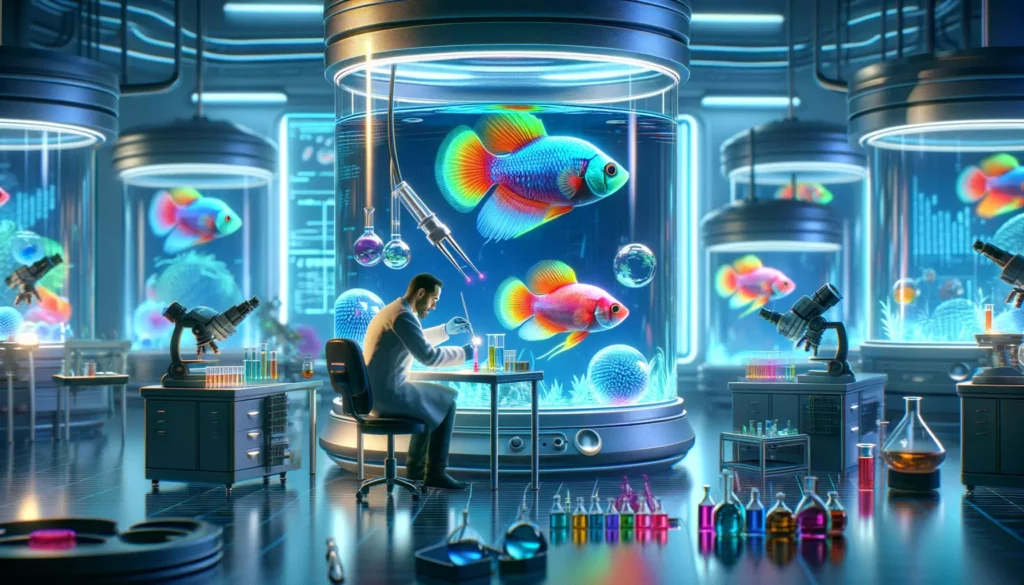
The breeding of GloFish involves significant regulatory and ethical considerations. Genetic modification in pets raises both interest and concern. In some countries, the sale and ownership of GloFish are regulated. These regulations aim to ensure environmental safety and ethical breeding practices.
Ethical considerations focus on the welfare of the fish. It’s important that genetic modification does not cause harm or suffering. Breeders and researchers must adhere to strict ethical standards. This includes ensuring the health and well-being of the fish throughout their lifecycle.
Environmental concerns are also paramount. There are measures in place to prevent GloFish from entering natural ecosystems. This is to avoid any potential impact on native fish populations and ecosystems.
The regulatory and ethical landscape surrounding GloFish is complex. It balances the interests of science, commerce, and animal welfare. As GloFish continue to gain popularity, these considerations remain at the forefront of discussions about their breeding and sale.
Comparison of GloFish and Natural Fish Coloration
GloFish and their natural counterparts exhibit stark differences in coloration. GloFish are known for their vivid, fluorescent colors. These are a result of genetic modification. In contrast, natural fish display colors produced through traditional evolutionary processes.
The natural coloration of fish serves various purposes. It can be for camouflage, attracting mates, or signaling danger. These colors are typically more subdued compared to GloFish. Natural fish might display bright colors, but they are usually not as intense as those of GloFish.
| Parameter | GloFish | Natural Fish |
|---|---|---|
| Primary Source of Color | Genetic Modification | Natural Evolutionary Processes |
| Brightness of Colors | Bright and Fluorescent | Typically More Subdued |
| Purpose of Colors in Fish | Attract Attention in Aquariums | Camouflage, Mate Attraction, Danger Signaling |
| Existence in the Wild | Nonexistent in the Wild | Present in the Wild |
| Popularity in Aquarium Hobby | High, as Visually Striking Decoration | Varies by Species, but Usually Less Bright |
| Impact on Natural Abilities of Fish | No Impact | Adapted to the Environment |
| Beauty and Diversity Appreciation | Astonishing Colors and Brightness Due to Genetics | Natural Diversity of Colors |
GloFish were engineered to stand out in aquariums. Their bright colors are not found in wild fish populations. This makes them a popular choice for those seeking a visually striking aquarium. However, it’s important to note that these modifications are purely aesthetic and do not enhance the fish’s natural abilities or behaviors.
The comparison highlights the contrast between human-engineered traits and natural evolution. It showcases the capabilities of genetic modification while also appreciating the beauty of natural biodiversity.
Breeding Outcomes and Color Heredity in GloFish
Breeding GloFish can result in interesting color heredity patterns. The fluorescent colors in GloFish are inheritable. When two GloFish breed, their offspring will typically inherit the fluorescent trait. However, the exact color outcomes can vary.
The breeding of different colored GloFish can produce hybrid colors. For example, breeding a green GloFish with a red one might produce offspring with a mix of these colors. However, the results are not always predictable due to the complexities of genetic inheritance.
Selective breeding can enhance certain color traits. Breeders often aim to intensify the brightness and hue of the colors. This process, over generations, can lead to the development of new and more vibrant color variations.
It’s important to note that breeding GloFish requires knowledge of genetics and fish care. Breeding should be done responsibly to ensure the health and well-being of the fish. The process also respects the ethical considerations associated with genetically modified organisms.
Rare and Uncommon GloFish Colors
In the GloFish world, certain colors are considered rare and uncommon. These unique colors are often the result of specific breeding efforts. They may not be widely available in the commercial market. These rare colors can include unique shades or patterns that are not commonly seen.
Breeders sometimes achieve these rare colors through selective breeding. This involves carefully choosing parent fish with desired traits. The process can take several generations to produce the specific color or pattern.
Uncommon GloFish colors often attract serious aquarium enthusiasts. These individuals are typically looking for something unique in their collections. The rarity of these colors can make them more desirable and sometimes more valuable.
As genetic engineering techniques continue to advance, the potential for even more unique and uncommon colors increases. This ongoing development keeps the GloFish community engaged and excited about future possibilities in GloFish coloration.

